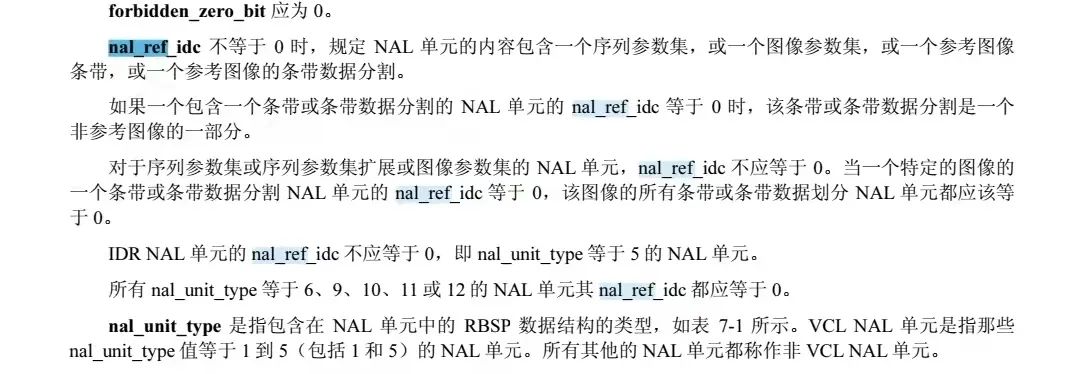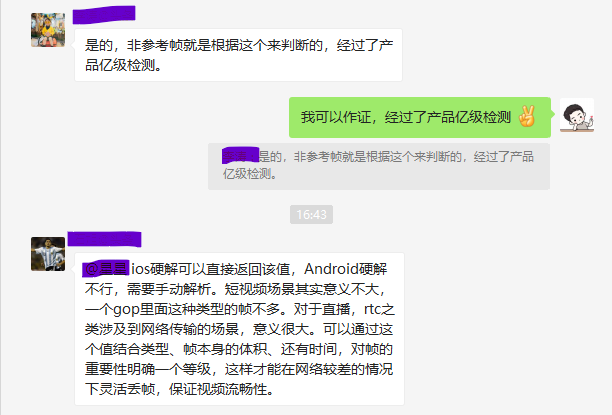百倍变速--解码到底能不能丢 非参考帧 ?FFmpeg 有话说!!!
昨天周六,群里面还有人在技术交流!!。
默默吐槽一下:这些人真卷啊,大周末还搞技术,是游戏不好玩还是电影不好看,他们肯定不知道 EDG 总冠军吧。

一开始是讨论剪映的 100 变速是如何实现,群主作为相关人士肯定就不方便透露这些了,不过也有其他大佬给出了思路。
讨论焦点还是围绕如何丢帧展开的。
百倍变速,比如正常速度下一帧是播放第 1s 时刻的内容,而变速后要播放 100s 时刻了。
此时的逻辑有以下几种情况:
如果下一个播放时刻要超过目前 GOP 大小了,那么就及时 seek 到离目标 pts 最近的关键帧,比如从 1s 变速后到了 100s ,那就 seek 到第 98s 。 如果下一个播放时刻在同一 GOP 内了,那就继续往下解码,判断解码后的帧 pts 不需要显示就直接丢弃再接着往后解 ,直到接近了目标时间点就显示。 seek 后的时间点没达到目标时间点的情况,需要继续解码的可以重复第二步。
以上是针对群内大佬的总结,拿着小本本赶紧记下来。
此时,还有大佬对解码丢帧给出了其他意见:

主要是针对非参考帧的丢帧处理,也是文章的重点内容。
当我们通过 av_read_frame 得到一个 AVPacket 之后,可以判断它的 nal_ref_idc 值来决定是否要丢弃。
如果为 0 ,说明其他帧不需要参考该帧,可以直接丢弃不发送给解码器,而不是解码后再丢帧。
如果你不清楚 nal_ref_idc 是什么意思 ?那么可以了解一下 H.264 码流 NALU 的概念。
H.264 码流传输时以 NALU 的形式进行,NALU 主要由一个字节的 HAL Header 和 RBSP 两部分组成。
HAL Header 的组成形式如下图所示:

HAL Header 的计算如下:
forbidden_zero_bit(1bit) + nal_ref_idc(2bit) + nal_unit_type(5bit)
nal_unit_type 不同的值代表不同类型的帧,解析 AVPacket 完全可以得到如上的信息,后面在公众号音视频开发进阶继续更新文章详解如何计算。
所以,在解码时完全是可以丢弃这些非参考帧的,放心大胆地操作吧。

而且丢非参考帧的操作也是经过了产品亿级检测的,这一点我确实可以作证!!!
FFmpeg 中的丢帧
以上的丢帧逻辑是根据 H.264 规范来的,那么在 FFmpeg 的源码中有没有针对这一逻辑做处理呢?
那必然是有的啊!!!
如果仔细看 ffplay 的源码,在源码中有如下的调用方式:
/* this thread gets the stream from the disk or the network */
static int read_thread(void *arg)
{
// 省略部分代码
for (i = 0; i < ic->nb_streams; i++) {
AVStream *st = ic->streams[i];
enum AVMediaType type = st->codecpar->codec_type;
// AVDISCARD_ALL 抛弃所有的帧
st->discard = AVDISCARD_ALL;
if (type >= 0 && wanted_stream_spec[type] && st_index[type] == -1)
if (avformat_match_stream_specifier(ic, st, wanted_stream_spec[type]) > 0)
st_index[type] = i;
}
// 省略部分代码
if (!video_disable)
st_index[AVMEDIA_TYPE_VIDEO] =
av_find_best_stream(ic, AVMEDIA_TYPE_VIDEO,
st_index[AVMEDIA_TYPE_VIDEO], -1, NULL, 0);
if (!audio_disable)
st_index[AVMEDIA_TYPE_AUDIO] =
av_find_best_stream(ic, AVMEDIA_TYPE_AUDIO,
st_index[AVMEDIA_TYPE_AUDIO],
st_index[AVMEDIA_TYPE_VIDEO],
NULL, 0);
/* open the streams */
if (st_index[AVMEDIA_TYPE_AUDIO] >= 0) {
// 开启解码线程
stream_component_open(is, st_index[AVMEDIA_TYPE_AUDIO]);
}
ret = -1;
if (st_index[AVMEDIA_TYPE_VIDEO] >= 0) {
// 开启解码线程
ret = stream_component_open(is, st_index[AVMEDIA_TYPE_VIDEO]);
}
// 省略代码
}
read_thread 方法运行在单独线程上,该方法首先进行解封装操作,然后开启一个线程进行解码,接下来调用 av_read_frame 方法读取 AVPacket 放到队列中供解码线程使用。
在 av_find_best_stream 方法之前先将 discard 置为 AVDISCARD_ALL ,过滤掉 AVStream 中的数据,接下来就是 stream_component_open 操作。
/* open a given stream. Return 0 if OK */
static int stream_component_open(VideoState *is, int stream_index)
{
// 省略部分代码
// AVDISCARD_DEFAULT 默认模式,过滤无效数据
ic->streams[stream_index]->discard = AVDISCARD_DEFAULT;
switch (avctx->codec_type) {
case AVMEDIA_TYPE_AUDIO:
// 省略部分代码
if ((ret = decoder_start(&is->auddec, audio_thread, "audio_decoder", is)) < 0)
goto out;
// 省略部分代码
case AVMEDIA_TYPE_VIDEO:
// 省略部分代码
if ((ret = decoder_start(&is->viddec, video_thread, "video_decoder", is)) < 0)
goto out;
// 省略部分代码
}
stream_component_open 方法又将 discard 置为了 AVDISCARD_DEFAULT ,仅过滤掉无效数据。
继续跟进这个 discard 字段,就会有新发现了!
关于 discard 的所有类型值和使用方式,FFmpeg 中有如下定义:
/**
* @ingroup lavc_decoding
*/
enum AVDiscard{
/* We leave some space between them for extensions (drop some
* keyframes for intra-only or drop just some bidir frames). */
// 不抛弃,不放弃任何数据
AVDISCARD_NONE =-16, ///< discard nothing
// 丢掉无用的数据,比如 size 为 0 这种
AVDISCARD_DEFAULT = 0, ///< discard useless packets like 0 size packets in avi
// 丢掉所有的非参考帧
AVDISCARD_NONREF = 8, ///< discard all non reference
// 丢掉所有的双向帧
AVDISCARD_BIDIR = 16, ///< discard all bidirectional frames
// 丢掉所有的非内帧
AVDISCARD_NONINTRA= 24, ///< discard all non intra frames
// 丢掉所有的非关键帧
AVDISCARD_NONKEY = 32, ///< discard all frames except keyframes
// 丢掉所有帧
AVDISCARD_ALL = 48, ///< discard all
};
所以,完全可以使用 discard 字段来标识解码时丢弃哪些帧。
另外,在 avcodec_send_packet 方法源码注释中也提示了可以通过 AVCodecContext.skip_frame 字段来决定丢弃哪些帧。
/**
* Internally, this call will copy relevant AVCodecContext fields, which can
* influence decoding per-packet, and apply them when the packet is actually
* decoded. (For example AVCodecContext.skip_frame, which might direct the
* decoder to drop the frame contained by the packet sent with this function.)
* 省略部分注释
*/
int avcodec_send_packet(AVCodecContext *avctx, const AVPacket *avpkt);
摘录了部分注释内容,写的就很清楚了。
所以,在解码时也可以不用自己解析 AVPacket 的 nal_ref_idc 字段值,直接通过 AVCodecContext.skip_frame 实现同样目的。
亲测有效,过滤非关键帧之后,解码出来的全是关键帧了。
以上,就是关于丢帧的一些分享,技术交流探讨欢迎加我微信 ezglumes 交流!!!

技术交流,欢迎加我微信:ezglumes ,拉你入技术交流群。
私信领取相关资料
推荐阅读:
觉得不错,点个在看呗~

